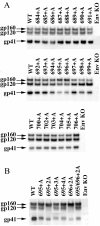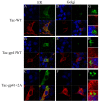The membrane-spanning domain of gp41 plays a critical role in intracellular trafficking of the HIV envelope protein
- PMID: 21073746
- PMCID: PMC2994783
- DOI: 10.1186/1742-4690-7-95
The membrane-spanning domain of gp41 plays a critical role in intracellular trafficking of the HIV envelope protein
Abstract
Background: The sequences of membrane-spanning domains (MSDs) on the gp41 subunit are highly conserved among many isolates of HIV-1. The GXXXG motif, a potential helix-helix interaction motif, and an arginine residue (rare in hydrophobic MSDs) are especially well conserved. These two conserved elements are expected to locate on the opposite sides of the MSD, if the MSD takes a α-helical secondary structure. A scanning alanine-insertion mutagenesis was performed to elucidate the structure-function relationship of gp41 MSD.
Results: A circular dichroism analysis of a synthetic gp41 MSD peptide determined that the secondary structure of the gp41 MSD was α-helical. We then performed a scanning alanine-insertion mutagenesis of the entire gp41 MSD, progressively shifting the relative positions of MSD segments around the helix axis. Altering the position of Gly694, the last residue of the GXXXG motif, relative to Arg696 (the number indicates the position of the amino acid residues in HXB2 Env) around the axis resulted in defective fusion. These mutants showed impaired processing of the gp160 precursor into gp120 and gp41. Furthermore, these Env mutants manifested inefficient intracellular transport in the endoplasmic reticulum and Golgi regions. Indeed, a transplantation of the gp41 MSD portion into the transmembrane domain of another membrane protein, Tac, altered its intracellular distribution. Our data suggest that the intact MSD α-helix is critical in the intracellular trafficking of HIV-1 Env.
Conclusions: The relative position between the highly conserved GXXXG motif and an arginine residue around the gp41 MSD α-helix is critical for intracellular trafficking of HIV-1 Env. The gp41 MSD region not only modulates membrane fusion but also controls biosynthesis of HIV-1 Env.
Figures








Similar articles
-
Mutations of conserved glycine residues within the membrane-spanning domain of human immunodeficiency virus type 1 gp41 can inhibit membrane fusion and incorporation of Env onto virions.Jpn J Infect Dis. 2006 Apr;59(2):77-84. Jpn J Infect Dis. 2006. PMID: 16632906
-
Role of envelope processing and gp41 membrane spanning domain in the formation of human immunodeficiency virus type 1 (HIV-1) fusion-competent envelope glycoprotein complex.Virus Res. 2007 Mar;124(1-2):103-12. doi: 10.1016/j.virusres.2006.10.009. Epub 2006 Nov 28. Virus Res. 2007. PMID: 17129629
-
Role of the specific amino acid sequence of the membrane-spanning domain of human immunodeficiency virus type 1 in membrane fusion.J Virol. 2005 Apr;79(8):4720-9. doi: 10.1128/JVI.79.8.4720-4729.2005. J Virol. 2005. PMID: 15795258 Free PMC article.
-
Conserved arginine residue in the membrane-spanning domain of HIV-1 gp41 is required for efficient membrane fusion.Protein Cell. 2011 May;2(5):369-76. doi: 10.1007/s13238-011-1051-0. Epub 2011 Jun 12. Protein Cell. 2011. PMID: 21667332 Free PMC article.
-
HIV-1 gp41: mediator of fusion and target for inhibition.AIDS Rev. 2003 Oct-Dec;5(4):214-21. AIDS Rev. 2003. PMID: 15012000 Review.
Cited by
-
Beyond anchoring: the expanding role of the hendra virus fusion protein transmembrane domain in protein folding, stability, and function.J Virol. 2012 Mar;86(6):3003-13. doi: 10.1128/JVI.05762-11. Epub 2012 Jan 11. J Virol. 2012. PMID: 22238302 Free PMC article.
-
Unique genotypic features of HIV-1 C gp41 membrane proximal external region variants during pregnancy relate to mother-to-child transmission via breastfeeding.J Clin Pediatr Neonatol. 2021;1(1):9-20. doi: 10.46439/pediatrics.1.003. J Clin Pediatr Neonatol. 2021. PMID: 34553192 Free PMC article.
-
Rotational Dynamics of The Transmembrane Domains Play an Important Role in Peptide Dynamics of Viral Fusion and Ion Channel Forming Proteins-A Molecular Dynamics Simulation Study.Viruses. 2022 Mar 28;14(4):699. doi: 10.3390/v14040699. Viruses. 2022. PMID: 35458429 Free PMC article.
-
Retrovirus glycoprotein functionality requires proper alignment of the ectodomain and the membrane-proximal cytoplasmic tail.J Virol. 2013 Dec;87(23):12805-13. doi: 10.1128/JVI.01847-13. Epub 2013 Sep 18. J Virol. 2013. PMID: 24049172 Free PMC article.
-
A Hydrophobic Target: Using the Paramyxovirus Fusion Protein Transmembrane Domain To Modulate Fusion Protein Stability.J Virol. 2019 Aug 13;93(17):e00863-19. doi: 10.1128/JVI.00863-19. Print 2019 Sep 1. J Virol. 2019. PMID: 31217248 Free PMC article.
References
Publication types
MeSH terms
Substances
Grants and funding
LinkOut - more resources
Full Text Sources
Medical

